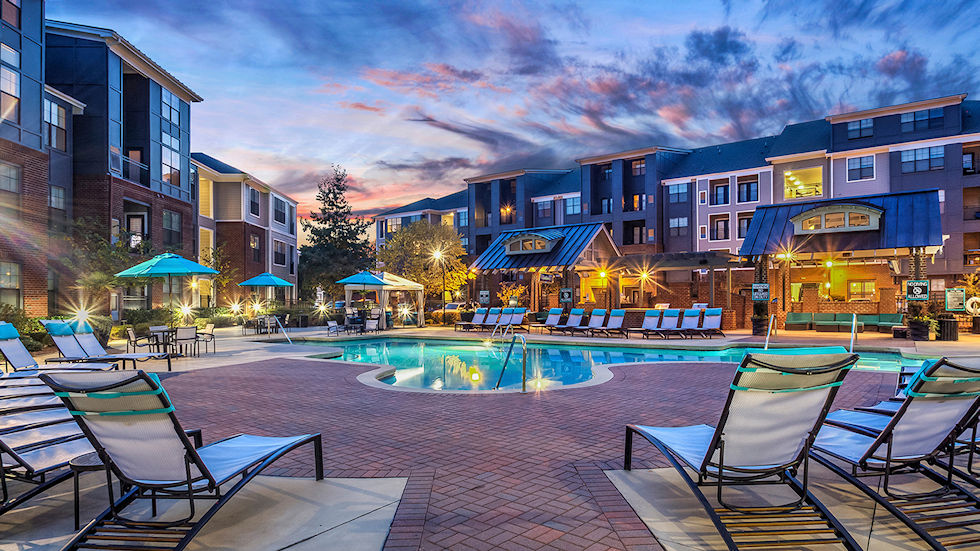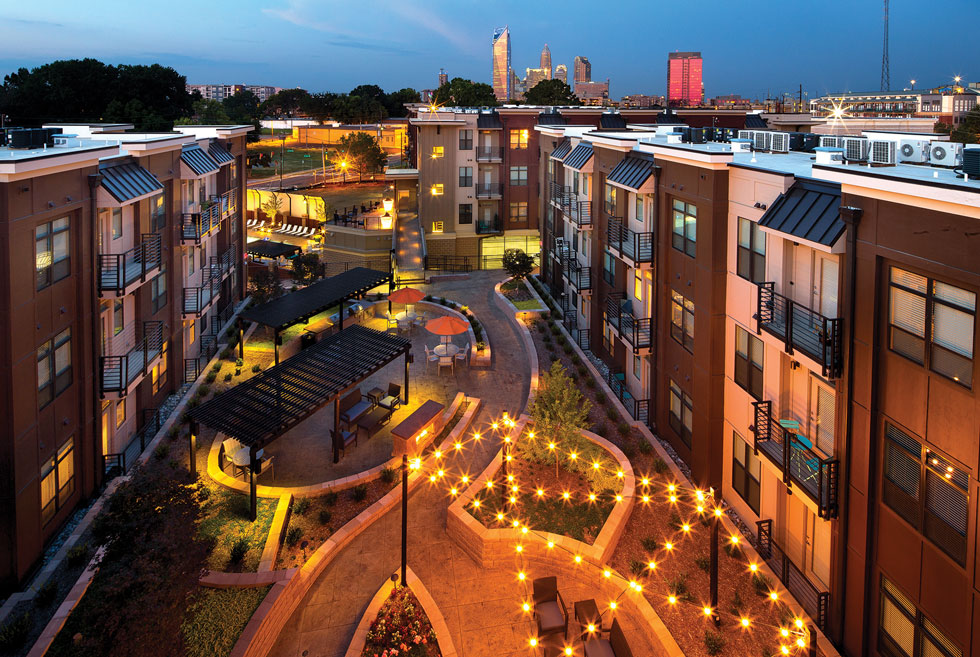With a focus on a diversified portfolio of institutional-quality apartment properties in knowledge economy growthmarkets, and unencumbered by regional office and staffing obligations, Bluerock Residential Growth REIT, Inc. (NYSE American: BRG) moves nimbly among real estate investment markets to provide live-work-play communities, attracting educated, highly paid workers.
The New York City-based REIT began operations in 2009 as Bluerock Enhanced Multifamily Trust, and CEO Ramin Kamfar says that even then, the company had identified the multi-faceted opportunity accompanying the U.S. economy's transition from manufacturing-based production to information-based production and services.
"We saw the growth of jobs outside the big cities and gateway markets, and with those jobs came highly educated workers, growing communities and populations, and highly compensated individuals who were renters by choice," Kamfar says.
Renters were looking for high-quality residential communities in which they could live, work and play, but such communities were underbuilt—and the properties that did exist were undervalued and had a large spread in pricing, he adds. "We saw long tailwinds to this trend and knew we could build a large business around it and deliver value to shareholders at the same time."
Core Flexibility
By 2012, Bluerock had positioned itself as a REIT and established the innovative operational strategy that would free the company to invest and grow across the multifamily markets.
Rather than open offices and hire staff to manage properties in specific submarkets, Bluerock began growing co-investment operating partnerships, teaming with national and regional bestin-class owner-operators that would allow the REIT to use their infrastructure in exchange for Bluerock's furnishing of 90% to 95% of the capital.
"Flexibility is part of our core DNA," Kamfar says. Bluerock’s objective is to generate value through off-market, relationship-based transactions and, at the asset level, through improvements to operations and properties. "Our infrastructure-light strategy allows us to survey the entire multifamily marketplace and pick our points. We can do core plus, class B value-add, and development, and since these markets cycle as capital moves in and out of them, we can enter and exit as we deem prudent. We’re much more active recyclers of capital because of this ability," he adds.
An initial public offering in March, 2014 raised nearly $50 million and that, along with two follow-on offerings, transformed Bluerock from a small private real estate investment company to a notable niche player with more than 5,000 units and a robust pipeline of commitments spread across the multifamily markets.
Proving Resiliency
By the end of 2019, Bluerock owned nearly 16,000 units in 53 properties, valued at $2.3 billion. Then came COVID-19, freezing execution on several fronts.
Bluerock moved first to secure the safety of residents and staff while fully servicing its customer base. Rent-growth programs to renovate thousands of units and add smart appliances were put on hold. "We had already made an investment in technology to switch our servicing operations to remote, but in execution, things became difficult," Kamfar says. "We had little guidance from government, we couldn’t enter apartments, and there was the moratorium on evictions. We shifted our strategy in the near term to preserving occupancy versus driving rents."
Although a few residents took advantage of the moratorium to stop paying their rent, and several requested workouts, the company's focus on the knowledge economy workforce provided a good amount of resilience and shielded the REIT from the income swings that many other multifamily owners endured during the pandemic. Our occupancy remained solid throughout the pandemic, and our lease rate grew by nearly 8% in April 2021," Kamfar says. Same store average rent also increased 1% year over year for the first quarter of this year, and same store net operating income increased nearly 1% over the same period.
Moreover, Bluerock acquired six multifamily properties totaling 1,898 units for $338 million in 2020, sold nine investments for total net proceeds of $182 million, and raised approximately $240 million through a preferred stock offering. "We delivered great shareholder return in 2020, particularly in light of the COVID impact, and our team worked hard to do it," Kamfar says.
The company has a preferred stock that it self-issues, giving it direct access to the capital markets and the ability to raise capital even during downturns. "And, because our management team owns roughly 30% of equity, we're fully aligned with our shareholders, making sure we’re judicious about issuing stock and creating value," the CEO says
2021 Opportunities
As the pandemic continues to recede, Bluerock is focusing even more aggressively on acquisitions.
Bluerock has always been big a believer in the Sun Belt growth market, and the pandemic only accelerated the movement of people to secondary markets and the trend of jobs moving with them, Kamfar observes. "We’re concentrating now on increasing our geographic footprint in the Southeast, Southwest, and Mountain West regions."
Barry Oxford, senior analyst at Colliers Securities, appreciates Bluerock’s geographic focus. "We like the Southeast and Southwest, because the data from U-Haul and other large logistics companies clearly shows that people are moving to these areas. Bluerock is in the right markets at the right time," he says.
Oxford also thinks that with its current 96% occupancy and focus on class A, Bluerock is unlikely to suffer when government subsidies for COVID-19 expire. "If you’re 100% leased, then you may not be pushing rents hard enough," he says. "But Bluerock’s portfolio is right there at 96%, which I term full occupancy."
Yet, acquisitions have become more competitive as investor interest in multifamily properties has grown along with the population of by-choice renters.
"When we were buying our first properties, our target multifamily markets were largely overlooked," Kamfar says. "Most public REITs were focused on the gateway markets, and private institutional capital was as well." Now spreads between gateway and secondary properties have dropped from 200 basis points to 50 basis points or less.
"It’s great for our shareholders, and we’re still able to execute our strategy, in part because it’s so relationship-driven," Kamfar says. "If we have nine partners, they multiply our sourcing and execution abilities by the same number."
Bluerock often invests in $100 million deals, maneuvering in this sweet spot that's too big for most individual investors and too small for large institutions or big private equity. "Buying deals of this size is much harder than buying $1 billion deals, but this is where we create value," Kamfar says. "We have a good reputation as a hand-shake team, whether as purchaser or seller, and our counterparties know they can count on us to execute on what we promise."
To date this year through the first quarter earnings release, the company had invested $28 million in an additional 816 units in three properties in two states. In a move that differentiates the REIT from other REITs investing in multifamily, Bluerock had also loaned $21 million under existing commitments in eight preferred-equity investments. Kamfar says the investments represent another way for Bluerock to use its expertise and network to generate attractive yields.
Gaurav Mehta, managing director of equity research at National Securities Corporation, sees such lending as having multiple advantages. "First, Bluerock receives income from payments made on these loans, and second, the yields are higher than those available from other investments," he says. "Third, making these loans favorably positions Bluerock to add to its acquisitions pipeline."
Also this year, the company has sold its investment in five properties for net proceeds totaling $102 million. "Given our infrastructure-light strategy, we underwrite our portfolio regularly to see if it still makes sense," Kamfar says. "We aggressively prune properties with lower organic growth profiles or more limited value-add qualities so we can allocate capital where we think we can best deliver value for shareholders."
On the operational front, Bluerock is leaning into the rent growth it had prepared for before the pandemic. Underway again is the SmartRents program, installing smart home technology in apartments to generate premiums in rental pricing.
"We’ll convert several thousand apartments this year, which we expect to provide a boost in operating income," Kamfar says. Also resuming is the unit renovation program, on schedule to improve about 1,000 units in 2021 and typically generating a market-leading return on investment of more than 20%.
In addition, Bluerock plans to reinvest the more than $260 million in cash preserved during the pandemic to drive its bottom line. Work is also afoot to become included in the RMZ, Morgan Stanley’s equity REIT index. "Index funds drive market valuations, and many investment funds require the REITS they invest in to be on it," Kamfar says.
Bluerock is focused on delivering strong results across all metrics on the balance sheet, but Kamfar says unit-level revenue growth speaks to the REIT's assets and communities in the market, and both have delivered industry-leading, same-community growth.
"These results are a direct result of our market strategy and operational execution," Kamfar says. "We don't necessarily want to be class A urban, but class A suburban, with investments that are live, work, and play. The Sun Belt economy continues to have markets that create jobs and income growth, and that’s where we want to be. That’s where we are."

